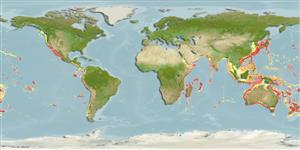Teleostei (teleosts) >
Anguilliformes (Eels and morays) >
Nettastomatidae (Duckbill eels)
Etymology: Nettastoma: Greek, netta = duck + Greek, stoma = mouth (Ref. 45335); parviceps: From the Latin parvus meaning little and caput meaning head, referring to the slightly smaller size of the head of this species compared to that of N. melanura, the only other species of the genus known to Günther..
More on author: Günther.
Environment: milieu / climate zone / depth range / distribution range
Ecology
Marine; benthopelagic; depth range 60 - 1190 m (Ref. 40819). Deep-water
Indo-Pacific: bitemperate distribution, recorded from Japan, Hawaii, eastern Australia, and southeastern Africa. Southeast Pacific: Chile (Ref. 9068). Rare or absent in equatorial waters.
Size / Weight / Age
Maturity: Lm ? range ? - ? cm
Max length : 82.0 cm TL male/unsexed; (Ref. 6591)
Short description
Morphology | Morphometrics
Vertebrae: 230. SO5 pore normally absent. Lateral line pores 49-58. Median vomerine teeth not enlarged. Posterior nostril above posterodorsal corner of eye. Other characteristics: Color gray; vertical fins black-edged; snout gray-black; iris and opercular regions silver.
Inhabits the continental slope (Ref. 7300, 75154) and shelf (Ref. 75154).
Life cycle and mating behavior
Maturity | Reproduction | Spawning | Eggs | Fecundity | Larvae
Castle, P.H.J., 1986. Nettastomatidae. p. 190-191. In M.M. Smith and P.C. Heemstra (eds.) Smiths' sea fishes. Springer-Verlag, Berlin. (Ref. 6591)
IUCN Red List Status (Ref. 130435)
Threat to humans
Harmless
Human uses
Fisheries: of no interest
More information
Common namesSynonymsMetabolismPredatorsEcotoxicologyReproductionMaturitySpawningSpawning aggregationFecundityEggsEgg development
Age/SizeGrowthLength-weightLength-lengthLength-frequenciesMorphometricsMorphologyLarvaeLarval dynamicsRecruitmentAbundanceBRUVS
ReferencesAquacultureAquaculture profileStrainsGeneticsElectrophoresesHeritabilityDiseasesProcessingNutrientsMass conversion
Tools
Special reports
Download XML
Internet sources
Estimates based on models
Preferred temperature (Ref.
123201): 7.8 - 17.5, mean 11.5 °C (based on 548 cells).
Phylogenetic diversity index (Ref.
82804): PD
50 = 0.5312 [Uniqueness, from 0.5 = low to 2.0 = high].
Bayesian length-weight: a=0.00089 (0.00036 - 0.00223), b=2.98 (2.77 - 3.19), in cm total length, based on LWR estimates for this (Sub)family-body shape (Ref.
93245).
Trophic level (Ref.
69278): 3.5 ±0.5 se; based on size and trophs of closest relatives
Resilience (Ref.
120179): Low, minimum population doubling time 4.5 - 14 years (Assuming tmax>10).
Fishing Vulnerability (Ref.
59153): Moderate to high vulnerability (53 of 100).
